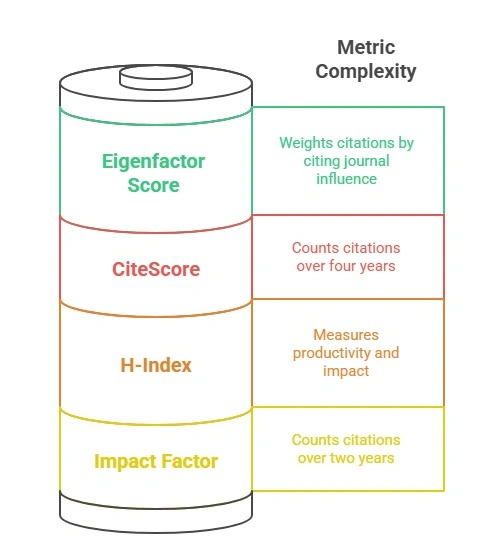What Are Journal Metrics?
In the world of academic publishing, journal metrics are like report cards for journals. They provide numerical data that reflect a journal’s influence, reach, and quality. Whether you’re a student, an early-career researcher, or a seasoned academic, understanding journal metrics is essential when selecting a journal to read, cite, or publish in. Journal metrics help separate reputable journals from less credible ones. For researchers, they serve as a benchmark for quality, impact, and prestige. Funding agencies, hiring committees, and academic institutions often rely on these numbers when making decisions about grants, tenure, or promotions. Simply put, metrics can make or break careers.
Commonly Used Journal Metrics
Impact Factor (IF)
- How It’s Calculated: The Impact Factor, developed by Clarivate Analytics, measures the average number of citations received per paper published in a journal over the previous two years. For example, if a journal published 100 articles in 2022 and 2023, and those articles received 300 citations in 2024, the IF would be 3.0.
- Strengths and Limitations: While widely recognized, the Impact Factor is not perfect. Different disciplines show drastic variation, and a few highly cited articles can skew the results It also doesn’t consider the quality of citations. So, although useful, IF should never be the sole metric you rely on.
Scopus Index
- Overview and Features: Scopus, developed by Elsevier, is a massive abstract and citation database that covers a wide range of disciplines. A journal indexed in Scopus is generally considered reputable. The Scopus Index tracks citations and includes several metrics like CiteScore, SNIP, and SJR.
- How to Access It: You can access Scopus metrics through its online platform. Many universities provide access, but some basic information can be viewed freely on journal publisher websites or tools like SCImago Journal Rank (SJR).
H-Index
- Definition and Use: The H-index measures both productivity and impact. If a researcher has an H-index of 20, it means they have 20 papers that have each been cited at least 20 times. This metric applies to both journals and individual authors.
- Author vs Journal H-Index: Author H-index reflects a researcher’s body of work, while journal H-index assesses the overall impact of the journal. While useful, it favors older researchers or journals with a long publication history.
Eigenfactor Score and CiteScore
- What Sets It Apart?: The Eigenfactor Score measures the importance of a journal based on how often articles from that journal are used. It weighs citations based on the influence of the citing journals, making it a more holistic metric than the Impact Factor.
- Comparison with Impact Factor: CiteScore is similar to IF but uses a four-year window instead of two. It’s calculated by dividing the number of citations by the number of documents published. Offered by Scopus, CiteScore includes all document types, not just research articles.
Journal metrics range from simple counts to complex weighting:

Using Journal Metrics for Evaluation
- Assessing Journal Quality: High journal metrics often indicate strong peer-review practices, rigorous editorial standards, and wide readership. However, quality also depends on the scope, relevance, and audience of the journal. Use numbers to guide you, but also read some articles to make informed decisions!
- Ranking and Visibility in Research: Journals with higher metrics tend to have greater visibility, which means your research is more likely to be seen and cited. If you’re aiming for academic influence, publishing in high-ranking journals gives your work a boost in credibility and reach.
- Choosing the Right Journal to Publish: Always match your research to a journal’s scope and audience. Metrics are important, but they’re just one piece of the puzzle. A lesser-known journal in your niche field might serve you better than a top-tier generalist one.
Journal Metrics for Researchers
- Career Implications of Journal Metrics: Publishing in high-impact journals can fast-track your career. Hiring committees and funding agencies often examine the journals where you publish your research. High metrics signal that your work meets high standards and resonates with the academic community.
- How Funders and Institutions Use Metrics: Organizations often use journal metrics to assess research impact when allocating grants or awarding promotions. They may prefer or even require publications in indexed journals with strong metrics, especially in competitive funding scenarios.
Best Practices for Researchers
- Always aim for relevance over rank.
- Avoid predatory journals with fake metrics.
- Use tools like Scopus, Google Scholar, or Web of Science to cross-check data.
- Diversify your publication strategy across journals with various strengths.
Misuse and Criticisms of Journal Metrics
- The Pitfalls of Metric Over-Reliance: Overusing metrics can lead to a toxic academic culture. Chasing numbers often leads to superficial research, self-citations, or even gaming the system. Metrics are tools, not the goal.
- Predatory Journals and Fake Metrics: Some shady publishers advertise fake metrics to lure in unsuspecting authors. Always verify journal indexing status on official databases like Scopus or Web of Science. If a journal’s metric sounds too good to be true, it probably is.
- Ethical Publishing and Responsible Metric Use:Use metrics as a guide—not gospel. Ethical publishing means focusing on research quality, transparency, and genuine contribution to knowledge. Responsible use of metrics leads to better academic environments for all.
Future of Journal Metrics
- Evolving Trends in Research Evaluation: As open-access publishing grows, new metrics are emerging. Expect to see a shift from citation counts to broader impact assessments that include engagement, collaboration, and interdisciplinary influence.
- Open Science and Transparent Metrics: Open science demands open metrics. Future metrics will likely include real-time citation tracking, public peer reviews, and integration with digital platforms. This transparency benefits both authors and readers alike.
Conclusion
Understanding journal metrics is essential in today’s academic world. Whether you’re choosing where to publish, evaluating research quality, or applying for grants, these numbers offer valuable insights—but they aren’t everything. Use them wisely, along with critical judgment, ethical practices, and a passion for good research. That’s the real formula for academic success.

Leave a Reply